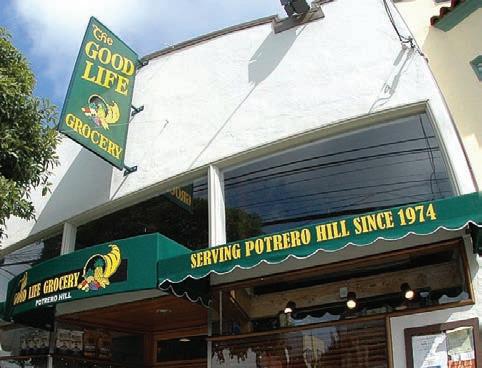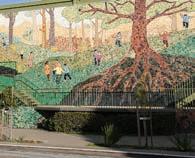










Finding that elusive San Francisco apartment can be challenging without substantial connections, budget and time to hunt. Securing a space to rent in Potrero Hill is almost as difficult as the most desirable City neighborhood, with strong demand to live in the sunny community.
Prices for a room in a Hill house, flat, or apartment generally start at $1,000 a month, and go up from there. One-bedrooms cost at least $2,000 monthly, with higher rents for units on the Hill’s North Slope, close to Caltrain, or with views. Data from
“We went above what we wanted to spend because demand goes up and the supply isn’t changing.”
rentjungle.com, which culls its statistics from thousands of online listings, puts rent for an average San Francisco one-bedroom at $1,845 a month, with two-bedrooms averaging $2,364. Average rents for one to three bedrooms in Potrero Hill is $3,389.
Tim Vanderet, 24, a City of Sunny-
vale transplant, lives on Arkansas and Mariposa streets with two other 20-something men. It’s their first postcollege apartment, which took them two months to find. Armed with a map of San Francisco neighborhoods, Vanderet had scoured Craigslist. He started at $1,000 a person for a three-bedroom apartment, but quickly learned that he’d have to pay more.
Potrero Hill emerged as a viable option for Vanderet and his friends after apartments in other neighborhoods proved beyond competitive, and prices continued to jump. Three-bedroom apartments in the Marina and North

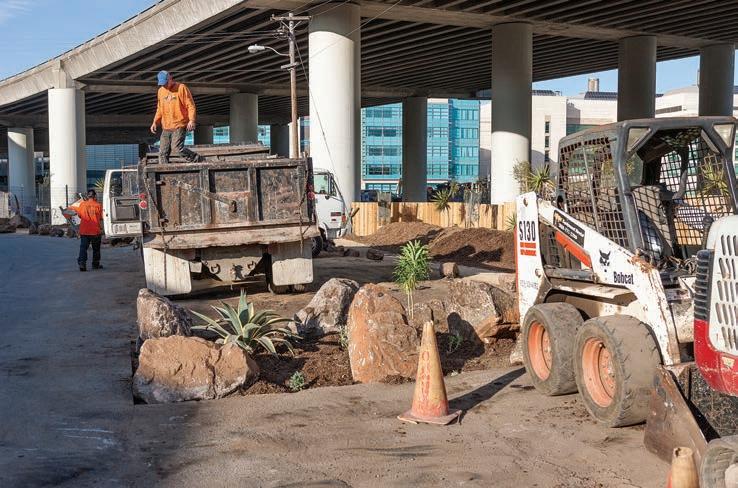 By LEE A NDREA MoRToN
By LEE A NDREA MoRToN
Gardening and beautification projects seem to be sprouting up on every corner of Potrero Hill, with greening and preservation initiatives at 15th and Rhode Island, Minnesota Street, Starr King Open Space, Progress Park, the Vermont Street Enclave, Pennsylvania Street Gardens, and along many sidewalks. Financial support for these projects has come mostly from residents, who invest their own time and dollars, occasionally securing public and private grants.
In an effort to provide ongoing funding for green space maintenance and infrastructure, the Potrero

Neighborhood Boosters Association is collaborating with community advocates to create a “Green Benefit District” (GBD), modeled after Community Benefit Districts (CBD). CBDs are special tax districts, authorized by state and local law, which allow property owners to tax their property while maintaining control over how the resulting revenues are spent. A
Concerns about the Potrero Hill Neighborhood House’s (NABE) financial condition were prompted last year after the nonprofit suspended its popular seniors’ lunch program between Christmas and New Year’s, when the rest of the nonprofit was closed.
“I think it's time for an expose on the financial condition of the NABE,”
The Neighborhood House, once the home of the View, is located at De Haro and 22nd streets.
Atop Potrero Hill, the Nabe has an amazing view of the City. PHoTogrAPH by DoN NoLTE
Edward Hatter, the NABE’s executive director, said. It’s “poor. One of my worst nightmares.”
The NABE recently closed a roughly $4,000 deficit for fiscal year 2012, with a total budget of $946,000. Forty-three percent of the nonprofit’s income comes from the San Francisco Department of Children, Youth and Their Families, which funds case management services for youth involved in the juvenile justice system, anger management counseling, and Experiment in Diversity, an afterschool tutoring and enrichment program. Other significant funders include the Bayview Hunters Point Foundation, which sup -
ports a counseling program for youth and young adult substance abusers, and the Golden Gate Regional Center, which pays for programs for mentally and physically disabled seniors. The balance of expenses are covered through earned income, such as renting space for events, or fundraising, through the annual Potrero Hill Festival and other activities.
In the face of the NABE’s intermittent financial troubles — three years ago the nonprofit sold a parcel it owned across the street from its building for $375,000 to help balance
Starting perhaps four decades ago, San Francisco’s essential character began to change, becoming much wealthier and less family-oriented. The event wasn’t overtly noted or celebrated, though, in retrospect, the closing of Playland, a 10-acre amusement park near Ocean Beach, in 1972 could serve as a marker. Back then the City’s economic engine was largely driven by roll-up-your-sleeves manufacturers and wholesalers, financed by cufflinked bankers and insurers, who mingled their families at Playland, Golden Gate Park, and Camp Mather.
Today, manufacturing and warehousing has been mostly squeezed out; the traditional banking and insurance sector — the kind where you knew the name of the banker who held your mortgage — is three-quarters the size it was just fifteen years ago. People who make or move things have largely left town, replaced by the newly dominate sectors: health care providers, scientists, data manipulators and managers, backed up by a steadily growing hospitality sector. Since 1990 the population of every income cohort other than the very poor — less than $25,000 a year — the City’s version of the middle class — $125,000 a year — and the wealthy — more than $175,000 annually — has declined. The “Big Four” — tycoons Stanford, Hopkins, Huntington, and Fair — have been replaced by at least 3,000 San Franciscans with similarly deep pockets.
The quarter million children who played in the still ample open spaces and went to school mid-century last have dwindled to less than half that amount, a meager 13 percent of the population. As families left the City so too did construction of family-sized housing. L ess than 200 single-family homes were built in the last ten years, compared to the almost 20,000 units that were erected in buildings with more than 20 units. In 2010 755 studio or one-bedroom units were constructed; while just 566 two-bedrooms or larger were created, three-quarters of which were two-bedrooms.
There are some countervailing trends to the concentration of wealth and childless adults in the City, though much of these are underground. An unknown but likely notable number of extended families — predominately Asian-Americans and L atinos — are moving in together, especially in the Southside neighborhoods, by modifying, legally or not, their garages and adding in-law apartments. Craft manufacturing — chocolates, beer, ceramics, and handbags, among other things — is trickling into San Francisco. Both of these movements bolster the ability of working wage families to stay, even thrive, in the City. But they are a drop in an ocean of twenty-somethings, single seniors, and the well-off who increasingly define San Francisco.
Whether San Francisco’s new face is appealing, or not, depends on one’s politics. Despite occasional rhetoric from City leaders, the needs of families with school age children are likely to continue to get short shrift compared to the desires of health care executives and high-tech investors. Attention will increasingly be paid to a growing population of infirm seniors — including those who have clung to the City through massively under-market, rent controlled apartments — the better-off of which will benefit from easy access to high quality medical facilities.
L ocal government’s priorities will evolve towards creating what amounts to a seven by seven luxury resort, with suitable, if pricey, amenities. After all, even our tourists are getting wealthier: 1.4 million fewer visitors came to San Francisco in 2010 than in 2000, yet those who came spent $680 million more on hotels, restaurants, and other services. Soon enough, the City will be less noted for its bridges, ushering in all comers, as the water that surrounds it, serving as a moat to keep out those who can’t afford to live here, or even sample our wares.


Editor, “Potrero Hill Town Hall Meeting Draws a Crowd” (December 2012) provides an incomplete picture of how the gathering was organized. Many neighborhood associations, groups and individuals wanted to meet with government representatives, including the Public Works, Police and Recreation and Parks departments. This coalition of entities encouraged the airing of a collection of issues and attendance at the Town Hall meeting.
Jane Westfall
McKinley Square Community Association
Editor, I read a “Short Cuts” piece in your January issue with a mixture of amusement and anger. Trumark Homes is proposing to knock down a couple of short buildings on 645 Texas Street and replace them with a big — 40 foot — building, with room for 101 residential units. The piece went on to describe City Code requirements with respect to the size of the units. Then came the interesting part: the City is allowing one off-street parking space for every two bedroom unit that’s greater than 1,000 square feet, and one more space per every other four units. This gives a total maximum off-street parking allotment of 39 to 59 spaces for a building with 101 units. Based on the average number of San Francisco households owning at least one car — 80 percent — this will, at minimum, add an additional 20 cars to street parking in that area of Texas Street.
The last sentence, though, was the real killer: the Planning Department "strongly encourages" Trumark to minimize the number of off-street
parking spaces because of the site's proximity to public transportation..." What are they smoking at the Planning Department? I guess they probably have the same stuff that the San Francisco Municipal Transportation Agency has; it must be really potent to induce such hallucinations about the state of public transit on Potrero Hill.
Jim Wilkins
Pennsylvania Street
Editor, I just read the October 2012 column by Mauri Schwartz, with the question from the parent of "Sam," who graduated from Cal State Hayward — now Cal State East Bay two years ago and still works at the bookstore where he was employed before investing all the time and money into a college degree.
Ms. Schwartz gave the parents pretty good advice to pass along to Sam. It’s the same information that career centers pass along to students on a regular basis. Our most important message to students is: don't wait until you graduate before starting your career search.
As the new director of academic advising and career education at Cal State East Bay, I'd like to reach out to Sam, and help with that resume revision and job search. Can you pass my contact information along to him — or the parent who wrote to Ms. Schwartz — and encourage him to contact me? I'd appreciate that.
Larry Bliss Director, Academic Advising and Career Education, California State University,East Bay
510.885.3621


The idea of demolishing 280’s northern section, near Mission Bay, is gaining traction as planners look for ways to usher in high-speed rail and transit-oriented development South of Market and Downtown. Last month Mayor Ed Lee’s transportation policy director, Gillian Gillett , floated a proposal modeled after the removals of the Embarcadero Freeway and a section of the Central Freeway, which revitalized the neighborhoods the roads used to divide. Gillett argued that replacing 280’s elevated portion with a street-level boulevard, from its terminus at Fourth and King Streets south to 16th Street, would improve the area’s livability, open up land to develop new neighborhoods, provide funding through real estate revenue, and create engineering solutions to facilitate the extension of Caltrain and California High-Speed Rail to the Transbay Transit Center. If the freeway is left standing, its pillars would present an engineering obstacle to running the train tracks underground; the only other feasible way to allow rail to safely and expediently cross 16th Street would be to dip 16th underneath the tracks. That would make the intersection a gateway to Mission Bay—even more hostile for pedestrians and bicyclists than it already is. In a moment that would make the City’s
mid-20th Century freeway protesters proud—including Potrero Hill’s Estelle West (aka, “the Goat Lady”) — Gillett told the crowd, “Let’s be San Francisco and take down the freeway.” Walk SF executive director Elizabeth Stampe called the proposal “an exciting opportunity to re-orient our City around sustainable public transportation and create a more walkable City.”
Parking restrictions — in this case, seemingly welcome — have been added to the west side of the south end of Connecticut Street, off Cesar Chavez, according to Hill resident John Zane L ate last year the City posted signs indicating one-hour parking from 7 a.m. to 2 p.m. to the left of the entrance to Cherin’s Appliances, with four-hour parking from 7 a.m. to 6 p.m. allowed to the right of the entrance. Prior to the changes, taxi drivers would park their personal vehicles in the area all day. “Now you can eat at Oscar’s Deli on the corner, leave your car at Dynamic Autobody without double parking — workout at Arena Ready fitness center, and take a daytime Zumba class or rehearse at Danzhaus, without worrying about your car,” Zane said. “The new parking restrictions also mean the street is regularly patrolled by police/parking agents, providing more safety and security than ever before.”

Cup of Blues is being coverted to a full-service restaurant, featuring healthy and moderately priced American foods. Plans by Josh Shertz, who’s owned the coffee and sandwich shop on the corner of 22nd and Minnesota streets for nearly 20 years, include a remodeled kitchen, new fixtures, flooring and other upgrades, as well as the addition of an accomplished chef. Though most of the funding for this transformation has been secured, Shertz is looking for community members to join a “crowd funding” effort to finance the remaining capital needs. Contributors will get naming rights for tables and menu items. Potential donors can find Shertz at Cup of Blues six days a week until 2 p.m…After spending the last decade catering to New York’s food scene, Chef Josie Smith-Malave , of Bravo TV’s “Top Chef,” is running a threemonth pop-up restaurant, Global Soul Corner , at Thee Parkside on 17th street. Smith-Malave, a clas -
sically trained bohemian chef and former women’s professional football player, has revamped the restaurant’s daily menu, and is offering Sunday brunch… Axis Cafe will remain open at least until this June. The building in which the eatery is located is being redeveloped, but its owners, the Nibbi Brothers, aren’t yet ready to raze the edifice. The café will operate under a new moniker, Araceli, with the same attitude, spirit and staff. Linda Edson will continue as manager while opening a new cafe with the same name on Treasure Island in partnership with Mark Smallcombe
L ast month the Community Opportunity Fund Project Selection Committee recommended that the Recreation and Park Commission award McKinley Square $38,551. The monies, which will be administered by Friends of McKinley Square, will be used for native plantings, installing a drinking fountain, and remediating hillside trails.

Stuart Tett is delighted with Potrero Hill’s bay views, and the ability to walk from his home to The Good Life Grocery, Chez Papa, and other neighborhood businesses. Tett tries to use Muni and Caltrain to get to his job in Redwood City and to play in the Mission District. But it isn’t easy. "Muni service in Potrero Hill is far below adequate." he said, noting that many South Bay commuters rely on cars instead of Caltrains for convenience, and many more for necessity.
There’s no direct Muni route from Tett’s home to the nearby Caltrain stations. And when he rides Muni to or from the Mission, the 22-Fillmore often ends at Potrero Avenue, with the driver announcing that the bus has made its last stop. As a result, a seemingly simple jaunt to the next neighborhood over can take 40 minutes, an encouragement to drive. “The terrain, the bad/slow public transit makes driving a necessity living in the area,” Tett said.
And it’s only going to get worse.
The building boom in the area means that when the more than 2,500 units slated for construction or being built are filled, thousands more San Franciscans will squeeze onto the same buses and trains, and fight for scarce parking spaces. And thousands more will be added to the emerging transportation snarl as a result of soon-to-be located jobs in new commercial centers emerging at Pier 70, Mission Bay, and Showplace Square.
Tett is one of the 22,000 a day riders on the 22-Fillmore, and the more than 30,000 daily riders using the T-Third. Demand for both of these transit lines will steadily climb; Muni has no plans for new transit lines to service Southside’s increasingly dense population, and has halted all work on transit corridors like 16th Street while a costly environmental review is completed. Meanwhile, City planners, in a year-old Eastern Neighborhoods traffic study, have declared the area’s roadways “at or near capacity” during rush hour periods.
Many residents believe that the Hill and Dogpatch already need more transit, open space, schools and other infrastructure for its current residents,
and that injecting more people into an area already lacking in basic public services is madness. This future means "total gridlock," said Rodney Minott, who has lived in Potrero for several decades, and who is active with Save The Hill, opposing Kaiser’s 16th Street development. Mississippi Street is a "nightmare during the morning and evening rush hours” with commuters trying to get to or from Downtown, he said.
“How about making sure the infrastructure is there? We're not doing that. We're not building the schools, the streets, the transit, the sewers, and the water. And that's the time bomb.”
TONY KELLY, P OTRERO B OOSTERS N EIGHBORHOOD A SSOCIATION ’S PRESIDENT AND A FORMER CANDIDATE FOR THE S AN F RANCISCO B OARD OF SU PERVISOR S
The story is similar for other amenities vital to a livable urban experience. Plans are in the works for new patches of open space in Dogpatch, Mission Bay, and Showplace Square, including as part of the Blue Greenway. But clashes over different uses for dogs, people, or plants—are likely to increase as the area’s population outstrips growth in its green space. The San Francisco Unified School District (SFUSD) has no plans for new schools in Dogpatch or Potrero Hill—even as more families with children move to the area—though one may ultimately be built in Mission Bay.
“How about making sure the infrastructure is there?" asked Tony Kelly, Potrero Boosters Neighborhood Association’s president and a former candidate for the San Francisco Board of Supervisors. "We're not doing that. We're not building the schools, the streets, the transit, the sewers, and the water. And that's the time bomb."
Potrero Hill’s residents can expect a brand-new park to open within the next few years. The only drawback is that it isn't in their neighborhood. The Recreation and Park Department's

latest acquisition is slated to be at 17th and Folsom Streets, on a parking lot that tends to flood in heavy rains, like the ones seen late last year.
Most of the public space projects planned for Potrero Hill are tied to new development. For example, roughly an acre of open space is included in the design for Daggett Place, near Showplace Square.
The only notable new fully public green spaces in the area will be along the waterfront. A combination park/ drainage area is being developed at 555 Illinois Street, on the site of the former BluePeter building. The historic cranes near Illinois Street will flank another new park expected to be completed by 2015. But those spaces could be in heavy demand by the residents of upwards of 1,000 new housing units proposed for adjacent Pier 70. Nothing on the scale of a Golden Gate, McLaren, or even Jackson Park is in the works for the Southside neighborhoods.
Despite calls from Webster Elementary School parents to create a kindergarten through eighth grade school in Potrero Hill, no new schools are planned for the neighborhood.
According to SF USD, that’s because residents haven’t shown much interest in the existing schools.
“There is plenty of capacity to accommodate Potrero Hill families who choose to go to school in the Potrero Hill neighborhood,” said SF USD spokeswoman Gentle Blythe, who noted that citywide, fewer than 25 percent of families list a neighborhood school as their first choice for their child’s placement.
However, Hill students who want to stay in the neighborhood after fifth grade have only one choice: International Studies Academy hosts sixth to twelfth graders on its campus, an age span that many Hill parents find unacceptable. “Kids naturally gravitate towards people that are older than them and want to model their behavior,” said Stacey Bartlett, a Webster parent and Potrero Kids at Daniel Webster preschool’s administrative director. “Why would you want to rush an 11 year-old to start acting like the high school girls or boys do? Can you imagine sending your 11 year-old daughter to school
INFRASTRUCTURE page 25
Parents have repeatedly tried to persuade the district to expand Daniel webster Elementary School, on 20th and Missouri streets, to a k through 8 campus to meet projected student demand.



Workshops:
Letterpress Printing and Hand Bookbinding
Art Classes and Team Building Events
Register at sfcb.org
“Al-Mutanabbi Street Starts Here” Exhibtion of Artist’s Books
February 1 – May 11, 2013/ Gallery Hours 10:00 - 5:00 M–F
Mark your calendar for
Roadworks: Steamroller Printing Festival
Sunday, September 29, 2013
New location: 375 Rhode Island Street 415 565 0545
Beach were renting for almost $5,500 per month. Sunset and Richmond district rentals were available for $1,000 a month per person, Vanderet said, but his housemates wanted to stay Southside for easy freeway and Caltrain access. They discovered that the Hill was centrally located, with more spacious rentals than other neighborhoods. Vanderet said his worries about the community having too much of a young family vibe have been unfounded.
Through Craigslist, the group secured a lease and moved into their apartment near Jackson Park last November, at a reasonably affordable rate of $3,600 per month, though it “went above what we wanted to spend,” Vanderet said. He theorized that rental prices are rising “because demand goes up and the supply isn’t changing.”
The search is the key element to finding a living situation. The Internet provides the most access to rental listings, with Craigslist a prominent site. Padmapper.com takes Craigslist listings and other online sources, organizes them into a more visually attractive display, and provides a comparison of rental prices in an area. Other sites, such as myapartmentmap.com, lists Potrero Hill, South of Market, Mission and Downtown apartments for rent in condominiums and other multi-unit buildings and luxury developments. Similar sites include hotpads.com, forrent.com, and mynewplace.com. Driving around or
walking a neighborhood can yield slim results, with the occasional “For Rent” sign posted on an apartment window; this method seems more productive for finding homes or units for sale.
Vanderet said he browsed through Craigslist posts up to three hours a day for seven weeks, to the point where he knew when a new listing was up and could pounce on it right away. An extreme example was a Mission District home that first posted online at 1 p.m. Vanderet immediately contacted the poster, who said a showing would be at 6 p.m. that night. Vanderet and his housemates arrived at the apartment at 5:45 p.m., holding applications, pay stubs and other materials, along with three other groups just as prepared to grab the spot. Over the course of the open house, Vanderet estimated that as many as 35 different parties came through expressing interest. By the end of the night, the notice had been removed from Craigslist. Presumably a lease was signed the next day. “There’s very quick turnaround,” he said. At another instance, at a possible Noe Valley apartment, Vanderet arrived at an open house to be told other prospective tenants had offered to pay the first month’s rent in cash upfront.
Hill resident Dan Couch, 25, experienced a similarly competitive field before moving from his parent’s Menlo Park home to his 23rd and Kansas streets apartment in 2011. He spent two months searching for a place in Potrero Hill, Mission, Bernal Heights and South of Market because of their proximity to Caltrain, which he takes
“I like coming to this L aundromat,” a Texas Street resident said, of Potrero Coin L aundry (PCL), located at 1310 18th Street. “I usually grab a bite at Farley’s while my clothes are tumbling.” The resident, who works South of Market, spends roughly two hours each time she visits the laundry, and is grateful for PCL’s wash-and-fold service. “Sometimes I drop off several loads of laundry. The staff does my laundry pretty quickly. I like how neat my washed clothes are folded,” she said.
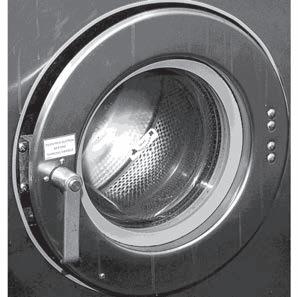
to do my laundry…I enjoy grocery shopping at Good Life Grocery while doing my laundry.” The resident was especially appreciative of Billy’s “tailor,” who did a great job altering her jeans.
According to a Castro resident, who had been staying at his friend’s apartment, two blocks from Billy’s, doing laundry is fun. “I am never bored here,” he said. “I go to the library to kill my two-hour laundry time.” He pointed toward the Potrero Hill Branch of San Francisco Public Library, down the street.
“This place sits in an excellent location,” said an 18th Street resident. “Especially, it’s next to a wonderful bar, which is one of my favorite places. I kick it in there every time I come to this neighborhood Laundromat. Once a month, for two hours.”
A Mariposa Street resident, who works at home, visits PCL three times a year. “Potrero Coin Laundry is clean and safe,” he said. “That’s what I like about this place. After I stuff my dirty clothes into one of the washers, I go home for an hour. My clothes are still in the same machine when I come back.”
Other Hill residents patronize another neighborhood L aundromat, Billy’s Dry Cleaners, at 1503 20th Street. “I’m glad that Billy’s is just one block from my apartment,” said a 20th Street resident, who became a Billy’s regular two years ago. “Closeness is everything to me. It takes about one and half hours
A L os Angeles visitor, however, preferred PCL over Billy’s because of its easy access to public transportation. “The 22 bus drops me right off at the corner of Plow,” he said with a smile, as he stood outside PCL smoking a cigarette. “It saves me lots of time…It’s so laid back here. Get a chance to hang out at Farley’s and eat at Plow. This neighborhood Laundromat is awesome. It has everything I need to do my laundry. It even has free Wi-Fi. Washers and dryers always available. No need to wait in line. The owner is very nice. Nice location, nice people with good vibes.”
Despite PCL’s popularity with its customers, potential rent increasesthreaten its longevity. As Potrero Hill’s property values continue to rise, so too do its rents, including on the 18th Street commercial strip. With a possible monthly rent hike of $1,000 or more, there’s a chance that one of the neighborhood’s Laundromats could go down the drain.
426 Connecticut
SOLD for $1,250,000
Represented seller
O -market sale with multiple o ers sold in 15 days! North slope 4BD/2BA home features living room with decorative replace, formal dining room and large kitchen.
784-86 Kansas
SOLD for $970,000
Represented buyer
An enviable north slope location garnered this 2-unit building multiple o ers; Christine’s client had the winning bid.
574 Wisconsin
SOLD for $645,000
Represented buyer
This 2BD/2BA condo with downtown views is now home to Christine’s client.



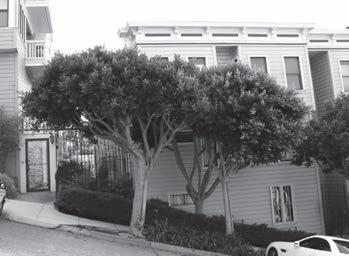
One October morning, at the south corner of Eighth and Market streets, I boarded an uncrowded Muni 19 on my way to interview the new principal at Downtown High School. Facing the windshield, I parked my electric wheelchair at the spot reserved for wheelchair users, and switched it off.
“You’re good,” the driver said, eying me in the rearview mirror.
I wanted to say, “No, I’m not” but am tongue-tied. I don’t feel secure because she neither strapped my wheelchair down nor buckled me up. “ Y-e-s,” I stuttered a few seconds later.
Securing a wheelchair with straps takes two minutes; buckling a wheelchair takes about ten seconds. If the bus got into an accident, I’d probably fly out of my wheelchair, hit the metal pole in front of me, and break my bones. Months after this incidence I still wonder why the driver didn’t strap my wheelchair down. Perhaps she was being lazy. I’d never had this problem before when riding a bus; not even during rush hour.
the 19 jolted past Mariposa Street and halted on Rhode Island Street. It was the wrong bus stop, but I didn’t mind getting off one stop too soon, one block from 18th Street; I was early for my interview appointment. At the front door I jerked my head back, seeing that the slope of the sidewalk was about 25 degrees. I trembled, sitting 23 inches above bus floor level. My wheelchair could flip over when I get off the lift.
I wheeled slowly to the tilted lift, leaning toward my left, and grasped the rail on each side. The driver low-


In 2010, one late fall afternoon, after tutoring English at Alameda College, I sped toward the MacArthur Boulevard bus stop, one stop from Mills College just in time to catch the 57 bus. The bus was crowded and stuffy.
“Where’re you going?” the driver asked.
“Mills College,” I said.
“Are you serious?” His cold eyes blinked at me.
“Yes,” I said, noticing passengers were staring at me. Feeling embarrassed, I clenched my teeth. I didn’t want to cruise the bumpy sidewalks back to Mills. It’d take 15 minutes to get there; by bus, less than a minute. The unhappy driver buckled me up and slammed the metal drawer behind my wheelchair.
When the 19 lurched forward, the side of my wheelchair joystick unit hit the fold-down seat. My hands pressed against the seat’s edge; I shook until
ered me to the sloped sidewalk. One, two, three. I wheeled out of the lift into the sidewalk, holding my breath until I reached the stop sign. I took a deep breath to calm down. The San Francisco Municipal Transportation Agency should place the bus stop at the flat northwest corner of Rhode Island and Mariposa streets; it isn’t safe for wheelchair users to get off at a sloped bus stop.
Putting my sweatshirt hood on, I cruised up Mariposa Street, then turned left on Vermont Street. I slowed down on the sidewalk, which has several raised concrete bumps that almost tipped my wheelchair over. I passed 18th Street and headed to Downtown to do my interview.
After finishing my interview an hour later, I sped to 19th Street, turned left on Rhode Island Street, and cruised toward 18th Street. But as soon as I turned right on that street, I couldn’t turn back: I was going down a steep hill. I tried to steer

my wheelchair toward the sidewalk, but it wobbled and skipped. I felt nauseated and tense; my stomach twitched and turned. My right fingers barely touched the joystick to steer the wheelchair straight. If I pushed it too hard, I feared that my wheelchair would go down too fast and flip over. My heart raced faster as my wheelchair bumped and moved from side to side. My spastic feet shook on the footrest; my eyes shifted to the bottom of the hill, which seemed unreachable. My stiff elbows thrust against the padded armrests; sinking deeper and deeper into my seat, I wheeled down the hill inch by inch, my breathing shallow. Relieved, I reached De Haro Street safely. Phew! I spun my wheelchair around. I will never go up or come down this steep hill again. A minute later I boarded the 19 heading to the Civic Center BART station. The driver, just like the 19’s that morning, without strapping my wheelchair or buckling me up, said: “You’re ready.”
I still felt sick to my stomach and grew even sicker when he jerked his chin at me and urged me again: “You’re ready.”
I just want to get back to Oakland as soon as possible. “Yes,” I said.
I feared that my wheelchair might move from side to side, but it didn’t shift an inch while the bus roared to my stop: Seventh and Market streets. When the driver lowered me to the curb, I realized that I didn’t have enough room to get out: the lift was too close to the curb rail. I sensed that the driver didn’t want to do more work, so I said nothing. I backed up my wheelchair a couple times before I could run it over the lift’s right side guard, like I was flying over a speed bump. My left spastic foot jumped out of the footrest and jerked. My wheelchair skipped to
RENTAL from page 5
to work in Mountain View every day. Couch was warned how stressful San Francisco house hunting can be, but in retrospect realized that at the start of his search “I was pretty lackadaisical about it” and that “at the first open house I thought I was prepared, but realized I was severely under prepared.” He had to up his game, and “from then on I was pretty diligent about bringing all the necessary paper work” to open houses and showings.
Couch even turned to a real estate agent for advice, through a family connection, and was pointed toward the Sunset District for apartments within his price range; an upper limit of roughly $1,200 per month per roommate. Determined to locate something Southside, he and two other friends managed to find a landlord ready to take on the trio through a persistent Craigslist search. But, according to Couch, as they were closing the deal the landlord called suddenly and said that he had until the end of that day to sign the lease or it’d go to someone else. Couch was at the Outside Lands Music and Arts Festival in Golden Gate Park; he left the concert and headed across town to make the deadline.
Richard Schelin, 54, a new student at the American College of Traditional Chinese Medicine on 455 Arkansas Street, is determined to live in the same neighborhood as he’s studying. He moved from Seattle in December, and has a temporary sublet in Bayview for $900 a month as he searches for a more permanent living situation. He doesn’t have a car, and plans on walking to school. However in his two months of looking he’s discovered “it’s quite expensive in Potrero.”
Schelin has been using the online NextDoor Potrero Hill community forum for rental leads, to no avail.
RENTAL next page
RENTAL from page 6
Others in the past few months have used the site as a place to search for housing or offer availability, such as one December post that advertised a $1,000 per month room in Dogpatch with two other housemates. View writer LeeAndrea Morton posted on the site before Christmas that she was looking for a room in the coming months, “I want to stay in the Hill! I work here and love the community so much,” she wrote.


Two years ago the City and County of San Francisco sold a former Tennessee Street fire station to Wayne de Geere III for $1,310,000. Since then, de Geere has sat on the property, with no renovation proposals filed with the San Francisco Planning Department. Whatever changes are made to the structure will have to meet requirements for historic preservation of the building and the area.
“We don’t have firm plans for the firehouse at the moment,” said de Geere, adding that he’s working to rezone the parcel from “public” to “urban mixed use.” “All parcels around it were automatically zoned UMU when the Eastern Neighborhoods Plan took effect a couple of years back, but this one was left behind.”
According to the Planning De -

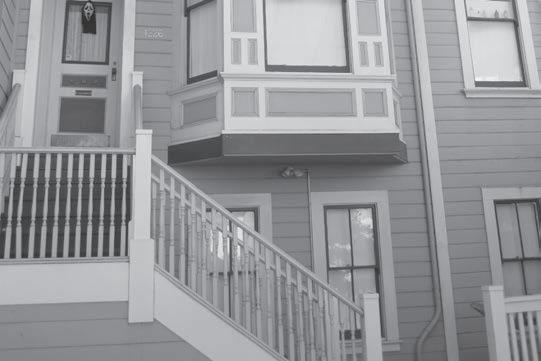


partment, “…all buildings constructed over 50 years ago and possess architectural or historical significance may be considered potential historic resources and proposed changes to these buildings may require some level of environmental review.” The building lies within the Dogpatch Historic District. It was first put into service by the San Francisco Fire Department (SFFD) January 14, 1926, replacing another fire facility located a block away, at 1009 Tennessee Street.
The parcel the fire station sits on is roughly 5,000 square feet. Jason Hinson, City and County of San Francisco Real Estate Division, said the two-story fire station is about 6,100 square feet.
“Engine 16 was stationed at 909 Tennessee Street beginning sometime in 1926, and remained there until
Architecturally Distinct
PotreroVictorian Home
1226 De HaroStreet
•4
•4
•Expansive
•Floor
•Unique
•Open
lots of light
•Large family room w/extra office area
•Entertainment space leading to large deck/garden
•Great home for entertaining/families
•Great storage and workshop area
•Remodeled/expanded in 2000



1970,” said Mindy Talmadge, SFFD’s public information officer. “Engine 16 has since been located at 2251 Greenwich Street. Battalion 10 (B10) was also stationed at 909 Tennessee from 1926 to 1941. In 1941, B10 was replaced by Battalion 11, and remained there until 1961. From 1970 to1974, a Fire Department tow truck operated out of 909 Tennessee Street. I believe after the tow truck was moved out, the property was used to store some of our antiquities.” The two-story brick building was designed by City architect, John Reid, Jr., and cost $39,400.91 to construct.
As early as 1952, City officials were suggesting that SFFD abandon 909 Tennessee Street. In 1969, Gage — Babcock & Associates, Oakland, recommended that a new fire station be constructed at Pennsylvania and 22nd streets.
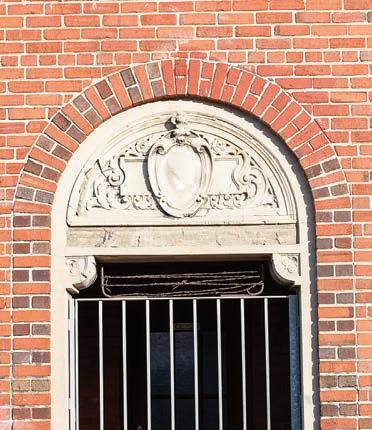
With the new quarter’s statistics coming out it is becoming clear that it’s currently a great time to be a seller and a more challenging time to be a buyer.
Over the past year the average days on the market for single family homes, condos, and 2-4 unit buildings has been just over one month. Most properties are selling FAST!
Sellers want to prepare themselves for a quick sales cycle. And Buyers should have their purchasing power ready to pounce on the right property before it’s scooped up by someone else.
For all of your real estate questions and needs, contact me any time!
















nonprofit organization representing the taxed property owners, as well as other stakeholders, usually manages a CBD.
San Francisco is home to thirteen CBDs; if successful Potrero Hill will be the City’s largest such district. Under the proposed GBD, commercial and residential property owners could be taxed between $20 and $45 annually, depending on how much land they own.
“Potrero Hill is the first to try this project on such a large scale,” said Tony Kelly, who, apart from one year when he ran for the San Francisco Board of Supervisors in District 10, has served as Boosters president since 2003. Kelly is leading the sizeable task of creating the GBD.

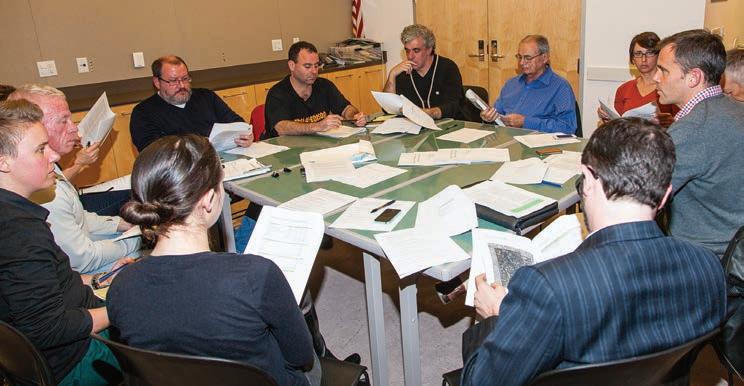
The idea for the Green Benefit District was conceived by Isabel Wade, founder of the Neighborhood Parks Council, now the San Francisco Parks Alliance. The Potrero Hill GBD was initially developed by Kelly, neighborhood park groups, and Michael Yarne, executive director at U P, Urban, a new nonprofit designed to foster public-private partnerships. The GBD Steering Committee, which meets monthly, consists of upwards of 25 community members and three chairs: Kelly, Bruce Huie and Jean Bogiages. Huie helped establish Progress Park; Bogiages is responsible for the green space revival on Utah Street. Steering committee meetings are open to the public.
CBDs typically consist of 10 to 20
parcels of land stretching over five or six blocks. Between 5,000 and 6,000 plots would be covered by Potrero Hill’s GBD. The area would span north and south from 16th Street to Cesar Chavez, and east to west from Potrero Avenue to Illinois Avenue. Other CBDs in San Francisco — such as at Civic Center, Noe Valley, and Union Square — have funded a variety of initiatives, including street cleaning and maintenance, public safety, beautification projects, and district advocacy. The Potrero Hill GBD would focus on improving neighborhood green spaces.



“The City of San Francisco has adopted plans to rezone this area, a plan that is expected to triple the population over the next twenty years. But as it is, there are not enough parks in Potrero Hill to support our current population,” explained Kelly. To assess support for the GBD, the steering committee plans on fielding a mail survey to every property on the Hill this spring. To create the district, supporters must obtain signatures from

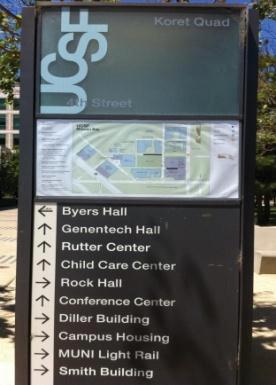
30 percent plus one of Potrero Hill and Dogpatch property owners who’d be paying the proposed property taxes. If the petition is successful, the Board of Supervisors would have to approve a resolution to create the GBD. Then, a vote-by-mail election would be held, in which 50 percent plus one of property owners would be needed to endorse the plan.
If the election is successful, a GBD management and green master plan will be created, including a proposal for a seven to 10 year property tax assessment to fund services. According to Kelly, upwards of $200,000 is needed for the GBD campaign effort. The district would likely generate between $200,000 and $300,000 annually. Organizers hope to start providing GBD services by 2014.
“Potrero Hill is a great place to launch the Green Benefit District because the people have a history of self-determination with their green spaces and, in some ways, we may be the most organized district in the City,” Kelly claimed.



UCSF’s last Long Range Development Plan (LRDP), created in 1996, was designed to guide the university’s physical development through 2012. UCSF is now embarking on its next LRDP, which has an expected planning horizon of about twenty years. Community involvement is a key facet of this planning process.







The purpose of the LRDP community participation is to ensure maximum public involvement in our planning process as we focus on neighborhoods in proximity to UCSF main campuses. UCSF works to ensure that the LRDP integrates the needs of UCSF with those of the diverse San Francisco community. This community workshop will focus on the Mission Bay campus.

As always, UCSF’s LRDP process will:
Ensure all interested parties have input into the plan
Deliver information the public needs about the plan

UCSF Mission Bay Campus is on the MUNI T-Third Street light rail line. If you drive, please park at no cost in the surface lot next to the Third Street Garage; this lot can be reached by taking 16th Street to 4th Street. Complimentary parking is not available in the garages.
Hold open and interactive processes
Identify the best ideas
UCSF fully ascribes to the Americans with Disabilities Act. If you have a need for accommodation, please call (415) 476-3206 or email community@cgr.ucsf.edu with your suggested accommodation.


Ensure all points of view are considered
If you would like to be on our E-MAIL notification list, or if you have any questions, please contact Michele.Davis@UCSF.edu.




Buyers love Potrero Hill’s charm, sense of community, and famously warm weather.
Inventory is at near-historic lows. In 2012 there were only 36 single family homes sold on Potrero Hill— this is the fourth-lowest number of home sales on Potrero Hill in 20 years. Low inventory caused many Potrero Hill homes to receive multiple offers in 2012.
Well-paid jobs in the technology sector increased dramatically in 2012. Many of these jobs were either in or quite nearby Potrero Hill.
Interest rates are at near-record lows. Buyers are eager to lock in low interest rates for the long-term.
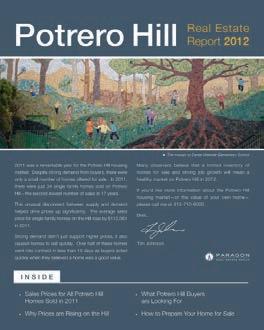

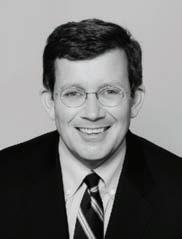

DRE#
 By SAShA LEKAC h
By SAShA LEKAC h
Former 4 Non Blondes drummer Dawn Richardson has called Potrero Hill home since 2001, when she moved from the Castro to Arkansas and 19th streets. Richardson launched her career in San Francisco in the early-1990s. Since then she’s taught music through a range of media, while playing drums in various bands and projects.
After moving to her North Slope home with her partner, she realized she’d come full circle; the music video for pop-rock band 4 Non Blondes’ hit 1993 single “What’s Up” included scenes of McKinley Square, with sweeping downtown views from 20th Street.
Richardson was introduced to the ensemble that would issue “What’s Up” through a connection
from L os Angeles, where she was born and raised. A friend there knew 4 Non Blondes were looking for a new drummer in 1991, after they fired percussionist Wanda Day, who died in 1997. Richardson — who’d studied music education and percussion at California State University, L os Angeles — traveled to the Bay Area, where the band was based, and quickly joined the group, which had recently signed with Interscope Records. Richardson, reflecting on her successful audition, called it her “big break.” 4 Non Blondes’s 1992 album Bigger, Better, Fast, More! went platinum in the U.S.
After the band broke up in 1994 Richardson pursued several musical endeavors, including drumming for locally-based blues-rock singer/ songwriter Tracy Chapman, and Van Morrison’s daughter Shana Morrison, who Richardson labeled a “pop meets blues meets country” singer. Richardson’s current focus is teaching. “I do a lot of that, that's my main gig,” she said. At Outer Mission-based Francisco Studios Richardson holds lessons for all ages and skill levels.
In addition to teaching, Richardson has written drum lesson books,
and created online teaching videos, with more in the works. According to Richardson, “there's not just one way to…” teach, especially with some of her students learning for fun while others aspiring to go pro. Her clients range from elementary school students to middle-aged rockers. Teaching invigorates the longtime drummer. “It is really fun playing,” she said. “It doesn't matter what form it takes for me.”
Over the years Richardson has had to supplement her career by waiting tables and taking other odd jobs. She’s thankful for the opportunity to teach. “Sometimes people recognize me,” she said. She was once eating in the Castro when the chef came out to tell her about his interest in drumming. She still gets letters and emails from fans, something she enjoys.
4 Non Blondes, with Richardson handling the sticks, made it to the big screen when the band’s song “Mary’s House” was featured in the 1993 film Wayne’s World 2. A cover of Van Halen’s “I’m the One” was part of the 1994 Airheads soundtrack. Sometimes the band’s tunes can be heard on television shows, which prompts phone calls from friends and family closely listening, Richardson said.
Aside from teaching, publishing five books through Mel Bay Publications, and contributing to online teaching videos for OnlineDrummer. com and her self-produced videos — the first episode of “The Beats of San Francisco” featured Potrero Hill’s very own crooked Vermont Street — Richardson has toured with Chapman since 2009, and is still working with Morrison. Although her long-distance touring days are mostly over, when accompanying Morrison — who also is a Pilates instructor — she often finds herself in small California towns. Occasionally, the band will cover Van Morrison’s songs, and opened for him when he performed in 2010 at the Masonic Center in San Francisco.
Richardson is also part of a female rock band, “Dolorata,” which



Dogpatch resident and professional jazz vocalist Clairdee grew up sixth of eight kids in a large musical family in Denver, Colorado. She was first approached by a Motown scout when, at age 14, she was performing with "The Majestics,” a group she assembled. Her mother objected to the idea of her moving to Detroit, wanting her talented daughter to have a proper education. Clairdee went on to receive a degree in fine arts and education from the University of Colorado, Boulder.
Clairdee got the spark for performing from her older sister, who would assemble the family to sing, dance and play music for local retirement homes and hospitals. "The looks on the faces of those people let me know the transformative power of music," Clairdee said. "And even at the very young age of five or six, I knew my life would be spent in music." She learned the violin in elementary school, then the viola and later the piano to assist with her jazz compositions and performances.
Clairdee was making a good living and name for herself as a jazz singer when she signed up to be represented by renowned jazz artist and promoter, John L evy, who died last year a few months shy of his 100th birthday.

She’d met L evy — who managed jazz greats Cannonball Adderley, George Shearing, Ramsey Lewis, Joe Williams and Nancy Wilson, among others — at a Wilson concert in 1989. Wilson's road manager advised Clairdee to "call John." It took Clairdee until 2004 to contact Levy, who simply asked "Why have I never heard of you?" Clairdee became the last artist Levy represented.
A self-described workaholic,
Clairdee loves to perform, and enjoys teaching. She’s taught youth classes through the San Francisco Symphony’s education department, in which she explained that jazz liberates performers to make things up, and taught students how to scat. She’s a constant learner herself, and knows that it’s as important to listen as it is to sing. She reveres the phrase that one should always "work with people, not on people."
Clairdee has lived in Dogpatch with her husband, Ken French, since 2003. She likes the neighborhood’s mix of people, industry and residences, along with the sunny weather and nearby Bay, as she adores water.
This year Clairdee is working on her latest compact disc, and will be touring from late-February to midMarch throughout Russia, performing on a multiple city tour with the Moscow Philharmonic and other big bands and orchestras.
For more information, www. Clairdee.com.
its books some Hill residents question the management’s capacity to effectively operate the institution, which opened on June 11, 1922. “Basic business principles were not being followed,” said one resident, who preferred not to be named. And Skip Charbonneau, the NABE’s board president, is “unable to meet the challenges of his board position.”
For his part, Charbonneau, who
has been board president for about four years, said he’s capable of handling the job, particularly now that he’s retired. “I know now I can. I have the time,” Charbonneau said. “We are in the black…Barely.” However, now that the NABE has sold the last of its land holdings it has virtually no financial reserves. “We don’t have any more to sell,” Charbonneau said. The View’s calls to the other five board members—Paulette Spencer, secretary, Allen Meadows, sergeant of arms, and Gloria Fisher, Barbara Topps, and Jeremy Hunter — were not returned.
According to Hatter, the NABE is working to address its fiscal challenges, in part, by contracting with the Urban Group to “republicize” the community resource. The Urban Group is being paid $5,000 to help the NABE raise money, reorganize its board, and update program descriptions. And Hatter plans to increase fundraising. In addition to the annual Beers, Blues and BBQ event, which raises $3,500 to $5,000, the nonprofit is considering holding a “gospel explosion,” featuring gospel choirs singing at the NABE. “Items like that,” Hatter said. And the NABE may do more mass mailings and find other ways to reach out to its neighbors, including contacting dot. coms, medical companies and academic institutions. “On top of that is writing proposals for additional funding,” Hatter added. The NABE is currently responding to a request for proposals that would bring $300,000 annually for
NABE page 26

The San Francisco Independent Film Festival (SF IndieFest) has a reputation for screening some of the best independent movies anywhere. The 15-year-old festival taps into the City’s seemingly infinite and rich well of talent, and features several movies made by Dogpatch or Potrero Hill-based directors. The festival runs February 7 to 21 at the Roxie Theater, with opening night at the Brava Theatre; and February 8 to 15 at the Shattuck in Berkeley.
The hilarious mockumentary Slide Rail Superman — made by David Santamaria, who teaches film at Bay Area Video Coalition, and Donald Harrison, a former Mission District resident who cut his teeth at South-of-Market’s Film Arts Foundation — is a rare cinematic gem in the “Of Cults, Manholes & Slide Rail Riders” shorts program. The film follows the ups and downs of one man and his sherpa-trainer’s dream to achieve greatness as a champion slide railer.
Santamaria plays the lead character, whose adventures in adversity are the heart and soul of this warm, funny bone-tickling tale. Slide Rail portrays slide railing as an urban competitive sport. The City, with its multitude of hills and stairways, is the perfect backdrop for a quirky quest to beat a mysterious Grim Reaper-like stranger in a red hoodie sliding down San Francisco’s longest banisters and railings. Shot in dozens of locations around San Francisco, the film features many beloved and recognizable landmarks in the Mission and Bernal Heights.
The concept for the movie came from Santamaria’s own childhood in L ong Island. “It was something me and my friends did growing up.” San-
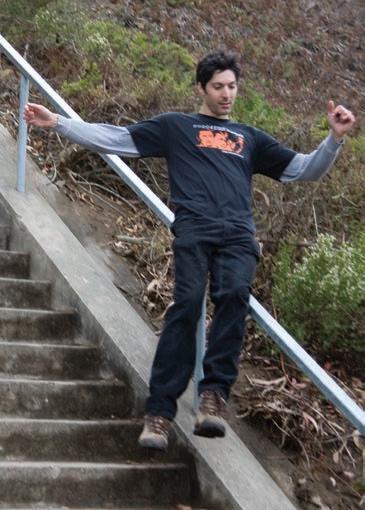


tamaria moved to San Francisco in the early-1990s. “In those days you could still live in a place with reasonable rent which gave you time to experiment and try different things.” With a degree in psychology and experience as a mental health counselor, the self-described late bloomer thought it was time to find a

career. He wanted to do something creative, and work with teens. Santamaria started making films in in his early 30s — “no-budget comedies” — while
attending City College.
Santamaria first collaborated with Harrison in 1996. The two met while working at a Market Street residential hotel for people with HIV/AIDS as counselor and administrative assistant respectively. They became friends, and made improvisational films together. Harrison moved to Michigan a few years ago to become director of the Ann Arbor Film Festival. In the last five years, Santamaria has kept himself busy teaching film to adults looking to re-train themselves or just starting out in life.
Manhole 452 is a fictional tale drawn from factual interviews and research that follows the reflections of a middle-aged man whose car was hit by an exploding manhole. Relying on first person narrative, the film directs the viewer’s attention to the varied shapes, sizes and patterns of manhole covers in the City, as the main character — who is never seen — rides the 38 Geary bus from the ocean to the Bay to his job fitting prosthetic limbs. Manhole 452 plunges below the surface to explore the hidden threat that lies beneath the streets. A voiceover explores the main character’s obsession with calculating odds, and the possibility of miracles, amid the presence of random violent occurrences.
Made by Hill resident, California College of Arts instructor and experimental artist Jeanne Finley and multimedia artist John Muse, Manhole 452 includes soundtrack contributions from local luminaries Pamela Z, of Project Artaud, and Jim McKee, of Earwax Productions.
Finally, The Beginning focuses on one moment of passion, fear and hope on a cold dark night as two naked strangers struggle to connect. The short is the work of Mission District filmmaker Brian Tolle and playwrightproducer Tom Swift.
For more information on screenings and tickets, visit s ndie.com.





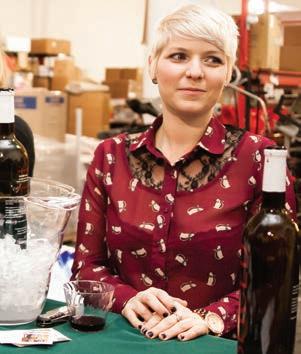



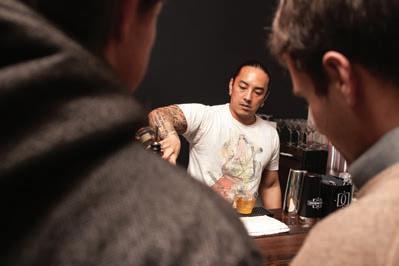





In 1973, Eric Redman published The Dance of L egislation, relying on his two years as a member of U.S. Senator Warren Magnuson's staff to trace the drafting and passage of a single piece of legislation. The book, which became a classic description of the legislative process, provides a vivid picture of the bureaucratic in ghting, political prerogatives, and Congressional courtesies necessary to make something happen on Capitol Hill. Throughout 2013, View publisher, San Francisco State University adjunct lecturer, and former Board of Supervisor candidate Steven Moss will publish installments of The Dance of L ocal Politics , highlighting the often humorous and sometimes teeth grinding process that makes up San Francisco politics. This is the second installment. If you’d like to support this project, either nancially or by helping to secure a publisher for it, contact: editor@ potreroview.net.
I walked up the worn, narrow staircase to Pastor Kenneth Sampson’s tiny office. A retired grocery store manager, the pastor lead a small Baptist congregation — less than a hundred souls — from a sagging Victorian-style building, located in San Francisco’s historically Black neighborhood, “Bayview.” I’d met him a few years after launching my nonprofit, which, after a ten year ef-
fort, had helped close the City’s two aging power plants — both located in supervisorial District 10 — and launched a series of programs to assist poor families lower their energy bills while creating “green” jobs. He was now president of the nonprofit’s board.
As I entered his cramped space, the pastor got up from behind his desk to shake my hand. As usual, he was dressed impeccably, in a brightly colored three-piece suit.
“Hello, Mr. Moss,” he said. He gestured towards the 1970’s-style brown vinyl chair, taken from some long dismantled dinette set, in front of his cluttered desk. “Good to see you.”
We sat down. We chatted for a few moments about his latest trip to Ghana, and the small school he’d just opened at the church. Our conversation trailed off. He looked at me impassively.
“So, what’s brings you here today?”
“Well, pastor, I’ve decided to run for supervisor, in District 10. I wanted to get your advice, and support.”
He looked at me. “You sure you want to do that,” he asked, a slight smile played on his lips. “In this town?”
Over the years Sampson and I had many conversations about local politics. Most of those revolved around the system’s petty, quid pro quo, characteristics. The opinions of the pastors at small African-Ameri-
can churches were ignored, elbowed aside by the handful of flashier, louder, church leaders with sizeable congregations. Politicians — particularly legendary power player and fixer Willie Brown — demanded absolute allegiance, the absence of which could trigger blocked construction permits, or the shut-off of funding for social service programs.
What bothered the pastor most was the un-kept political promises that were regularly made to address the violence, joblessness, and poverty that plagued Bayview, and its even more isolated and derelict neighbor, Hunters Point. That concern prompted Sampson’s primary guidance to me about the nonprofit — no matter what, get the services out on the street — advice I’d followed, regularly fielding teams of community members trained to install energy efficient light bulbs and refrigerators, and water-saving toilets.
“Yes, well, someone has to do it,” I said, weakly. “I think I can make a difference,” I quickly followed up, more firmly. “I know the district, and its needs. I understand how the process works. I mean, I teach it!”
“God bless you,” replied Sampson. “If you’re willing to do it, you have my support.”
“Thank you. I really appreciate that. I’m wondering, though, how do you think African-Americans will feel about a White guy running in a district that’s traditionally been represented by a Black person?”
Sampson leaned forward from his chair, his hands templed on the desk. “Steve, you’re not White. You’re Jewish. You’ll do fine.”
While Sampson’s evocation of the historical connection between Jews and Blacks gave me deep comfort, it was an echo from an era that had largely passed. Traditional AfricanAmerican religious leaders clung fiercely to the centrality of Israel, the holiness of the Jewish people, and the ties that were created a half-century ago, as part of the Civil Rights movement, when prominent rabbis marched shoulder to shoulder with Black activists. But more secular African-Americans were drawn to the Palestinian’s cause — viewing Israel’s occupation of the West Bank and Gaza as akin to apartheid — or, more prevalently, were too busy raising families and earning a living to worry much about religion or Middle East politics.
From the perspective of the District 10 elections, the neighborhood Black churches’ influence was waning, hollowed out by a steady migration of African-Americans from Bayview-Hunters Point to the East Bay suburbs of Pittsburg, Antioch and elsewhere — where large numbers were caught up in the 2008 housing foreclosure crises — and the disintegration of traditional family structures.
Forty years ago almost twothirds of Black children were being raised in a two-parent home; more recently that percentage had been cut almost in half. Many of San Francisco’s Black church goers have been lost to the suburbs, the pressures of single-parent families, or the nation’s general drift towards

POTRERO BRANCH 1616 20th STREET 355 2822
Tuesday 10 am - 8 pm, Wednesday 12 noon - 8 pm
Thursday 10 am - 6 pm, Friday 1 pm - 6 pm
Saturday and Sunday 1 pm - 6 pm
Monday CLOSED
By LyNNE BARNES, PoTRERo BRANCh LIBRARIANThe San Francisco Public Library will be closed on Monday, February 18, for Presidents’ Day.
Women’s Voices. Join best-selling authors Pam Houston, Zoe Fitzgerald Carter, Mara Purl, Alison Bartlett, Barbara Graham, and Victoria Zackheim as they read from their fiction and nonfiction work. February 9, 1 to 2:30 p.m.
25 Great Apps for Students, Parents, and Teachers. An interactive program that explores 25 educational apps for iOS/Android devices. Learn how to find the best apps to stay organized, be productive, juggle multiple tasks, and quickly find information. At the end, attendees may share their favorite apps with others. February 10, 3 to 4:30 p.m.
Book-a-Librarian: Family History Research Assistance. Need help researching your family history? Schedule a one-on-one appointment with a librarian for research assistance or personalized training on how to use the library’s genealogy resources. Call 355.2822 to request a 30-minute appointment up to two weeks in advance. February 3, 10, 24, 1 to 2:30 p.m.
eBook and eAudiobook Help Sessions. Bring your Kindle, Nook, iPod, or other eReader device with you and learn how to download books and other materials from the library website for free. For adults, 18+. February 6, 13, 20, 27, 6:30 p.m.
Akeelah and the Bee. A young girl learns to believe in herself and value her intelligence in this critically acclaimed, family-friendly drama. For school-age children. February 2, 3 to 4:30 p.m.
Musical Storytelling. Sally sparks imaginations using physical theater, dance, music, and colorful props and costumes. She promotes self-confidence, creativity, and language skills using drum, flute, accordion, and other instruments. For children and their families. February 16, 4 to 5 p.m.
Baby Rhyme and Play Time. For infants up to 18 months old and their caregiver. February 5, 12, 19, 26, 1:15 to 1:45 p.m.
Family Storytime. Storytime features stories, songs, and rhymes. For children up to five years and their caregiver. February 7, 14, 21, 28, 10:30 to 11 a.m. and 11:15 to 11:45 a.m.
Fun Flicks. This film program is offered every second Wednesday of the month, and includes short films based on children’s books and stories. February’s film will be Four Seasons in the Life of Ludovic. For children ages three to eight years. February 13, 6:30 to 7:15 p.m.
Homework Help. A library volunteer will be available to help Kindergarten through sixth grade students with homework. February 5, 12, 19, 26, 4 to 6 p.m.
Steel to Wheels Exhibit. The Potrero Branch, in partnership with a guest curator, will host an exhibition dedicated to one of Potrero Hill’s few remaining examples of industrial architecture: the Cor-O-Van moving company’s structures on 16th Street, between 17th and Mississippi streets. Metal and brick structures occupied by Cor-O-Van once housed the West Coast’s largest steel-producing factory and are significant examples of turn-of-the-century and early 20th-century construction. This art exhibition sheds light on important, underexamined aspects of Potrero Hill’s industrial past and envisions the possibilities of its future. Opening reception: February 23, 6 p.m. Exhibit runs February 23 to April 25.
The Potrero Hill Book Club meets at the library every third Wednesday evening. February’s selection is Gone Girl by Gillian Flynn February 20, 7 to 8:30 p.m.
Creative Writing Workshop. Join writer, filmmaker, journalist Shevi Rosenfeld Loewinger for a free class to help you write stories, develop characters, and find your own unique voice, all in a supportive and creative environment. February 7, 14, 21, 28, 12:30 to 2:30 p.m. Information:sheviros@gmail.com or 415.602.7961.






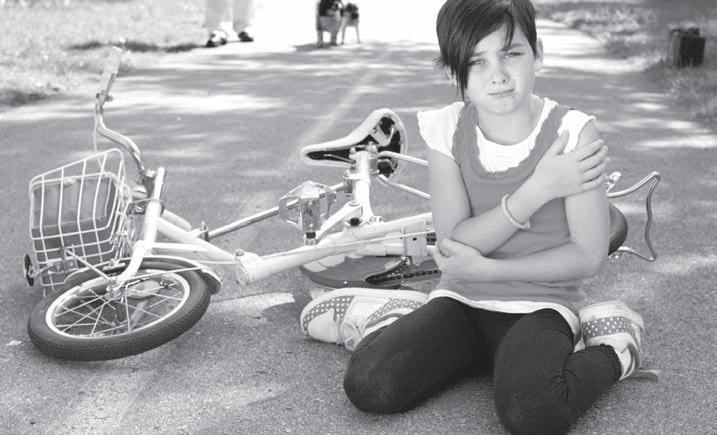

We are excited to announce that in October 2012, HUD awarded a $300,000 Choice Neighborhoods Planning grant to Bridge Housing to support BRIDGE’s Rebuild Potrero project!
The grant pro ides RID with a ni e opport nity to engage the comm nity and other Potrero sta eholders in a two year process to create a cohesi e So th Potrero Transformation Plan, concentrating specifically on family ser ices for not only Potrero Terrace and Anne residents, t for the larger comm nity as well. e have spent the past few years creating a master plan focused primarily on the physical environment for the redeveloped neighborhood his grant will allow us to focus on the social environment n the coming two years, , along with our consultants nterprises, will work with neighborhood institutions and residents to create a cohesive strategy to deliver programs and services that increase opportunities and positive outcomes in the critical areas of education, employment, health, violence prevention, and technology for existing and future outh otrero residents
Weekly Zumba Class: Ready to move your body and get your heart pumping to high energy music? Free Zumba classes at the NABE every Monday from 6:00-7:00 pm.
New Family Garden Work Days: Tuesdays 10am-12pm Saturdays 12-3pm
For more Information, call 415-806-1429
is now working with the otrero community to identify community leaders to serve on an dvisory ommittee to guide the hoice eighborhood lanning process he dvisory ommittee will serve as the key group to guide the work of and ridge ousing through a five phase process that includes
✔ thorough household needs assessment conducted by otrero errace and nnex residents
✔ community needs and capacity review of community organi ations in otrero
✔ est practices research on comprehensive health programs in public housing
✔ n analysis of available resources with ity gencies
✔ valuation and echnology ntegration lans for key otrero organi ations
✔ ohesive strategies to meet agreed upon outcomes related to education, health, job development and violence prevention hroughout this two year process, the ebuild otrero ommunity uilding roup which meets on the first hursdays of ebruary, pril, une, ugust, ctober and ecember at the , will provide input on the research fndings and help coordinate larger community convenings with the larger otrero neighborhood dditionally, the dvisory ommittee will meet monthly to oversee the implementation of the planning process
For more information, call 415-806-1429 or email potrero@bridgehousing.com
See more at www.rebuildpotrero.com
Join us...
Monday, February 11th for a COMMUNITY MEETING to discuss a proposed UCSF research building at San Francisco General Hospital and Trauma Center (SFGH)
UCSF proposes to build a new research building at San Francisco General Hospital and Trauma Center (SFGH) to comply with University of California seismic requirements. The new building would provide an improved, seismically resistant environment for research on the SFGH campus, which is an important part of the SFGH-UCSF partnership and a signi cant bene t to the SFGH patient population.
This rst Community Meeting will give an overview of the proposed work that UCSF is considering at SFGH. We are in the early stages of this process. We are seeking your feedback at this meeting and at others in the future.
If you would like to be on UCSF’s email noti cation list, please email community@cgr.ucsf.edu, specifying the campus site(s) of interest: SFGH, Parnassus, Mission Bay, Laurel Heights, Mount Zion.
UCSF fully ascribes to the Americans with Disabilities Act. If at any time you feel you have a need for accommodation, please contact 415-476-3206 or community@cgr.ucsf.edu with your suggested accommodation. For Spanish translation service please contact us at least 72 hours in advance at Barbara.Bagot-Lopez@ucsf.edu / 415.476.8318.
Roughly fifty years ago, in a quest to understand life’s meaning, Terry Lindahl started meeting with a group of other seekers in North Beach. “I was originally interested in existentialism,” Lindahl recalled, as he sat in Farley’s, where he can regularly be spotted in his trademark Fedora-style hat. “But then through reading Peter Ouspsenski I came upon Gurdjieff.”
George Ivanovich Gurdjieff emerged as a spiritual teacher midcentury last. His synthesis of past teachings indicated that humankind has the potential to evolve its consciousness. He believed that most people live in a state of hypnotic "waking sleep," but that there are ways to penetrate this smothering blanket of mundane consciousness to achieve higher states of mind. Gurdjieff developed various approaches for increasing awareness, which included music, movements, group and individual work. A key element of these methods was to set up experiments to observe ingrained habits of the mind and cultivate moments of critical insight.
“For example, take small walks with the intention to experience the sensation of the space you occupy in the solar system,” said Lindahl. “Observe what other interests distract you from the work you intended.” Gurdjieff believed that he had to constantly innovate and create new “alarm clocks” to awaken his sleeping students until

the change had sunk in.
Lindahl—who helped raise seven children, and as a licensed architect designed the original San Francisco International Airport boarding lounge, Daly City Civic Center, and Shoe Biz’s Haight Street outlet, among other projects—has spent most of his adult life intensively studying Gurdjieff’s teachings, and leading groups in its practice. In 1993, under his leadership the San Francisco Gurdjieff Society purchased what had been the New Potrero Theater, at 18th and Connecticut streets. Lindahl spent the next two decades renovating the structure—including straightening out-the theater’s slated floor —to make it a suitable for the Society.
“It amazes me to realize that this month will mark 20 years of the growth of the facilities of the San Francisco Gurdjieff Society here on the Hill,” said Lindhal. “Shortly after we moved in we roasted a lamb on a spit on the street front to meet the neighbors. We’ve had several open houses over the years, but largely have gone quietly about the business of converting the premises from a condemned unreinforced masonry building to a creditable contribution to the Potrero gestalt.”
L indahl’s lifelong engagement with Gurdjieff was initially nurtured by Henry John Sinclair, also known as “Lord Pentland,” who was a disciple GuRFJIEFF page 26
Acompáñenos... el lunes 11 de febrero para una REUNIÓN COMUNITARIA para hablar acerca del propuesto edificio de investigación de UCSF en el Hospital General de San Francisco (SFGH)
UCSF está proponiendo construir un nuevo edi cio de investigación en el Hospital General de San Francisco (SFGH) para cumplir con los requisitos antisísmicos de la Universidad de California. La nueva construcción proporcionaría un edi cio mejorado y más resistente a los terremotos para la investigación en el campus de SFGH, lo cual es un componente esencial de la alianza entre SFGH y UCSF y ofrecería bene cios signi cativos a la población de pacientes del SFGH. Esta primera reunión comunitaria proporcionará una visión general de las obras propuestas que está considerando UCSF en SFGH. Estamos en las etapas tempranas de este proceso. Le solicitamos sus opiniones en esta reunión y en otras reuniones futuras.
Si le gustaría estar en la lista de noti cación por correo electrónico de UCSF, por favor envíe un mensaje a community@cgr.ucsf.edu, especi cando cuál es el campus que le interesa: SFGH, Parnassus, Mission Bay, Laurel Heights, Mount Zion.
UCSF cumple plenamente con la Ley de Americanos Incapacitados (Americans with Disabilities Act). Si en algún momento usted piensa que necesita una comodidad especial, por favor comuníquese con 415-476-3206 o community@cgr.ucsf.edu para sugerir su ajuste. Para pedir servicio de traducción al español, por favor comuníquese con Barbara.Bagot-Lopez@ucsf.edu / 415.476.8318 por lo menos 72 horas antes del evento.





Featuring historical photographs and contemporary art inspired by the metal and brick structures that once housed the largest steel-producing factory on the west coast, these exhibitions will shed light on Potrero Hill's industrial past while envisioning the possibilities of its future.

Exhibition
6-8 pm, Saturday, Feb. 23rd Potrero Branch library, 1616 20th Street 7-9 pm, Friday, March 1st Farley s Coffee, 1315 18th Street



February 1 through 10
Theater:
The Saroyan o’Neill Project
The Postage Stamp Theater, a new workshop performance space, with two classic 20th-century American one-act plays: Hello Out There by William Saroyan and The Long Voyage Home by Eugene O’Neill. Fridays and Saturdays, 8 p.m.; Sundays, 7 p.m. Tickets: $5-20. Potrero Hill Neighborhood House, 953 DeHaro Street.
Make Art: Valentine
Snail Mail Social
ARCH hosts a Valentine’s Snail Mail Social, where participants can create a Valentine for all their sweeties. Annie Yu will bring custom designed stationery, along with an assortment of stamps, tapes and papers to make a unique letter. Come type a letter (on an actual typewriter!) and give someone a good mail day. Free. 1 to 4 p.m. Potrero Hill Neighborhood House, 953 DeHaro Street.

2-3
Event: Black History Month at Bayview opera house
Celebrate Black History Month, with many special guests and performers, including Village Dancers of Crossroads, Dr. Albirda Rose, Seastrunk Brothers, Patricia Wilder, Rena M. Guidry, and many more. Saturday, 7 p.m.; Sunday, 3 p.m. Free. Bayview Opera House, Ruth Williams Memorial Theater, 4705 Third Street. Information: 824.0386.
2-3
Community: Pennsylvania Street
Garden Planting Party
Join the planting party at the new park at 17th and Pennsylvania streets. Expert gardeners will lead planting teams. Come ready to garden; no experience necessary. Many hands make light work. Lunch and drinks at 1 p.m. Plenty of gloves and tools for everyone. 10 a.m to 1 p.m. and 2 to 5 p.m. 100 Pennsylavannia Avenue. Information: psgsf.org.

Lunar year Celebration: Asian Art Museum
Celebrate the Snake. Chinese American International School students present classical music and dance from Chinese ethnic minorities to kick off the Lunar New Year. After the performance, enjoy Oliver Chin’s presentation about Chinese zodiac animals and their characteristics, and discover something new about yourself. Chin has written more than a dozen books, including the series Tales from the Chinese Zodiac. Also, make an art project to take home with SCRAP, the nonprofit creative reuse center. 11 a.m. to 4 p.m. Free. Asian Art Museum, 200 Larkin Street. Information: asianart.org.

sample great comedies, horror flicks, love stories, documentaries, and short films. Then have a good time at one of the many after-parties celebrating the festival’s Quinceañera. Tickets: $10-20. See the website for schedule and details: sfindie.com.
February 9 and 16
Art: Naked at the Art Museum Scavenger hunt


Lecture: Teen Mental health
What does good mental health look like in teens? Join parents from across the Bay Area for this informative talk by teen expert, Michael Y. Simon. Hear specific ideas and strategies that will help you and your teen through the high school years. Learn how to gauge academic and social success; and how the absence of symptoms don’t equate to adolescent mental health; rather, good mental health is a work in progress that requires consistent help from parents and other trusted adults. Michael Simon is a licensed marriage and family therapist and the founder of Practical Help for Parents. He’s recently authored The Approximate Parent:Discovering Strategies that Work with Your Teenager. $5 donation. 7 to 9 p.m. French American International School, Arts Pavillion, 66 Page Street. Information: parentcoalition.net.
February 7 through 16
Film: San Francisco Independent Film Festival
The San Francisco Independent Film Festival, the Bay Area’s premier showcase for fine independent films and digital programs, celebrates its 15th year. See some of the most cuttingedge indie films today — by Lynn Hershmann, Potrero Hill’s Jeanne C. Finley, and Vincent Garglugo, to name a few—meet top-notch filmmakers, and
Go on a surprising search for nudity in art through the centuries at the Legion of Honor to celebrate Valentine’s Day. Scrutinize provocative paintings, startling sculptures, dazzling decorative objects, unclad athletes, a vixen-like Venus, a hunky Hercules, bathing beauties, striking stargazers, sultry Shades, and more. No previous experience with art required. 2 to 4:30 p.m. Tickets: $20 (not including museum admission). Legion of Honor, Lincoln Park, 100 34th Avenue. Information: WatsonAdventures.com or by phone via OvationTix at 866.811.4111.

Dinner: heath Ceramics
Chefs Jordan Grosser and Ted Fleury of Stag Dining Group have created an excellent dinner to be served family-style at Heath Ceramics. Guests will learn the company’s backstory and its vision for this Mission outpost. Special guest Matt Dick of Small Trade Company, one of Heath’s artist studios, will discuss his designs for uniforms and workwear for design-friendly dining destinations. Heath Ceramics was founded by Edith Heath in Sausalito in 1948. Cocktails, 6 p.m.; dinner, 7 p.m. Tickets: $140. Information: thebolditalic.com/ events/5635-a-heath-warming-dinner (for event) and heathdinner.eventbrite. com (for tickets).
Event: Lunar New year at American College of Traditional Chinese Medicine (ACTCM)
This year’s San Francisco Silent Film Festival will be held at the historic Castro Theatre. The one-day festival of silent film masterpieces kicks off with the magical romance Snow White (1916; director J. Searle Dawley), one of the first features Walt Disney watched as a 16-year-old newsboy in Kansas City. Other screenings include a rare program of early Buster Keaton short films, as well as The Thief of Bagdad (1924; director Raoul Walsh); Mary Pickford’s last silent film, My Best Girl (1927; director Sam Taylor); and Faust (1926; director F.W. Murnau). Talented musicians Donald Sosin, on grand piano; Christian Elliott, on the Mighty Wurlitzer; and the Mont Alto Motion Picture Orchestra will accompany the five programs. 10 a.m. to 9 p.m. Tickets: $5-15. Castro Theatre, 429 Castro Street. Information: silentfilm.org.
Performance:
The original Scratch-N-Sniff Variety Show

The Original ScratchN-Sniff Show is a most unusual interactive variety show. Each performance includes six to eight unique specialty acts, each no more than 10 minutes, with interactive “Signature Scratch-NSniff Elements,” with “Scent-based Match-Making” experiments occurring between each. Acts include live music, comedy, dancers, sword swallowing, magic, invented instruments, juggling buffalo, and a host of other wonderful off-beat, wacky, and weird performances. A truly authentic San Francisco experience. 7 p.m. Tickets: $10. 50 Mason Social House, 50 Mason Street. Information: ShowInfo@gmail. com.
potrero hill
what are you
1501
| 415-864-SITA
Celebrate the Year of the Snake with a day of fun and free events for the whole family. Watch the Lion Dancers perform, learn how to make dumplings, try your hand at calligraphy, make your own Chinese lantern, tour the herbal gardens, and much more. There will be free demonstrations of acupuncture, massage, and tai chi. The kids will love the bouncy house. Food and refreshments will be served. 11 a.m. to 2 p.m. (Lion Dancers at 1 p.m.) ACTCM, 450 Connecticut Street.
Community Meeting:
uCSF Mission Bay Development Plan Workshop #2
This Mission Bay workshop will focus on soliciting feedback from community participants regarding Mission Bay development. 6:30 to 9:30 pm. Free. UCSF, Cardiovascular Research Building (Lobby), 535 Mission Bay Boulevard. South. Information: Michele.Davis@ ucsf.edu.
The View asked Hill resident and career expert Mauri Schwartz to answer questions from job seekers.
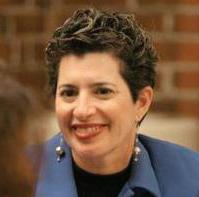
Q: What do hiring managers want to see in a cover letter? How long should it be?
A: I’ll start by saying that the vast majority of cover letters are never read. Yes, that’s right. Recruiters and hiring managers sift through hundreds of resumes; most of them ignore cover letters. This is even true when the job posting specifically requests a cover. That said, you should write your cover letter as if it’ll be read, because you have no way of knowing whether or not the person reviewing your application will be one of the few who do.
Even those who read your cover letter don’t have the time or inclination to read a page-long essay. Keep it succinct, not more than half a page, and three, possibly four, paragraphs. Each paragraph should answer one of these three questions, in this order
W HY YOU? Where ‘you’ is the company. Introduce yourself and in two or three sentences, convey your interest in the company, the specific position, and even the hiring manager, if appropriate, with enthusiasm. Your explanation should include information that shows you’ve done your research. Some hiring managers who read cover letters tell me that they’ve more than once rejected an applicant whose cover letter was so generic that it could have been sent for any job at any company. They want to see at the beginning that you’ve taken the time to distinguish them from the rest of the pack, to see why you think they’re special. Keep in mind that the cover letter could be their first impression of you, and you know what they say about first impressions. At the same time, be careful not to be overly solicitous.
W HY M E? In this section, tell the reader why you should be considered for the position; why you’re special. Choose two or three of the company’s highest priority requirements and write a sentence or two that describe your achievements that illustrate to the hiring manager that you possess the required qualifications. Don’t just tell them you have the experience. Show them by describing key accomplishments, your actions and the results. To keep your cover letter easily readable, your paragraphs should only be five or six lines long. You may need to use two paragraphs for this segment, extending your letter to four paragraphs, but still only half a page in total.
W HAT N E XT? This last paragraph should be the shortest and simplest, and may be the one that’s generic. It generally tells the reader that you want a chance to discuss your qualifications, and indicates the next step to be an interview.
Most cover letters these days are actually the body of an email message, with your resume as the only attachment. However, if a cover letter is specifically requested or you’re delivering a hard copy, create a separate document and use a formal business format, including your return address, the name and address of the person to whom you’re writing, a salutation or greeting, followed by the body of your message. At the end include a complimentary close, “Thank you for your consideration,” and your first and last name.
For the salutation, it’s polite to write “Dear Mr. (or Ms.) Brown,” rather than use their first name. If you don’t know the name of the person who’ll be receiving your letter, exclude the salutation completely. Don’t use phrases such as “To whom it may concern,” “Dear sir or madam,” or “Dear hiring manager.” Believe me, I’ve seen it all.
Mauri Schwartz is President / CEO of Career Insiders. Submit your questions to: Mauri@CareerInsiders.com.


Being a good doctor is about more than practicing good medicine. It’s about preventing illness. Being proactive. Taking time to really listen. And giving our members the personalized care they deserve.


I want to make sure he learns a second language.
either passive secularism or charismatic fundamentalism. As recently as the 1990s Bayview-Hunters Point’s population was two-thirds Black. By 2010 it was almost equally divided between African-Americans, Asian-Americans, and L atinos. The European-American population is steadily growing, with such a significant number of gays that a new
moniker had been coined for the community; “Gayview.”
My nonprofit work, starting in 2001, was mostly with Bayview’s Black leadership. While the nonprofit had provided services to poor households in the district regardless of race, because African-Americans had historically been most politically engaged and economically disenfranchised, we’d made extra efforts to recruit them into our training and job programs. I didn’t know

much about the Asian-American community — which was even more dominate in another part of the district, Visitacion Valley — or the Latino population, which was oriented towards churches, social centers, and businesses outside the district, mostly in the nearby Mission neighborhood.
While I hoped to get my fair share of votes from Bayview-Hunters Point, with several other AfricanAmericans and two Asian-Americans in the race I wasn’t counting on those communities to get elected. It was another District 10 community, Potrero Hill — were I raised by daughter, and owned the community newspaper, the View — and its tiny neighbor, Dogpatch, located just north of Bayview, where I was looking to get the main body of my support. Come
@ American College of
Sunday. Fe ruary 0th am 2pm
Food. Family Acti ities. Fun. This e ent is FREE and open to pu lic.
DRUMMER from page 13
has played at Bay Area venues, including Bottom of the Hill and The Independent on Divisadero Street. In addition, she plays locally in her instrumental rock duo “Mental 99” with Joe Gore, who also performs with Tracy Chapman and does sound design for Apple. She called the duo a “big giant experiment.” With her on drums and Gore on guitar, the two write their own songs and perform covers of classics. Because of the group’s small size, “I get to play a lot,” Richardson said.
Mental 99 whose name is a riff off the Daly City Asian supermarket 99 Ranch Market — is a chance for Richardson to use what she calls her growing collection of “percussion toys,” such as a timpani mallet, various shakers, and a water drum.
“We try to bring in a lot of sound and texture,” she said. They recorded their self-titled debut album in 2010 at a one-day live studio session in Berkeley, and expect to release another set of tracks this year.
Richardson sees herself playing drums indefinitely. “It's clearly not a phase. I’ll be playing ‘til I die.” After all, she said, being a fulltime drummer is “not a horrible job to have.”
More information about Richardson and drum lessons can be found at www.dawnrichardson.com.

Happy new lunar year






Potrero Hill is a great place to call home. I know because over the past decade, I’ve helped dozens of clients nd their perfect spot on the Hill. I found mine and have lived here for 19 years. When you’re considering your next move, let me earn your business.
Chris Worman and a friend were walking west on 18th Street after having dinner at Umi, the Japanese sushi restaurant, at around 11 p.m. They encountered an older woman who lived off 18th Street, who asked Worman and his friend to watch her walk from the street into her home, explaining that she was feeling unsafe. Worman and friend quickly agreed, and stood sentry as the Hill resident walked safely to her door. They then continued to 18th and Connecticut Street, where a friend who recommended Umi to Worman lives.
As Worman and friend neared the corner of 18th and Arkansas Street, approaching the patch of trees located alongside the sidewalk, their walk was suddenly disrupted. “The muggers came up behind my friend and I very quickly; not long enough to notice we were being followed until they said turn around.”
The muggers demanded money and phones. Noting that the muggers were armed with guns, Worman and friend quickly handed over their belongings. “They said ‘don’t look
at us,’ and hopped into their dark, late-model Ford Explorer and drove off uphill on 18th street.”
San Francisco Police Department officers arrived within five minutes of being called from Worman’s friend’s house. Worman immediately contacted his credit card company to cancel his card. While on the phone speaking with a representative, Woman was informed that someone was trying to charge his card at a Daly City Chevron Station. Worman concluded that the muggers had driven straight to the station in an attempt to purchase gasoline using his stolen card. The transaction wasn’t successful, since the thieves didn’t have the card’s pin numbers. Worman hopes that the muggers were caught on camera at the station.
“My first instinct was hand them my wallet. Simply put, there were guns and I didn't think about anything but 'here you go.' It was quite transactional,” said Worman. “What would I tell others? If there are weapons involved don't be stupid, just hand over your stuff. And I certainly do not believe if I had a gun it would have helped.”


with 19 year-old boys?”
The district is working with demographers to evaluate geographic shifts in San Francisco’s population, Blythe said, but any plans to construct new campuses are in the future. SF USD has until 2027 to commit to building a new school in Mission Bay. As a result, most of the City’s schools, including the most sought after high schools, will remain on the West side.
The City is banking on less being more when it comes to the area’s sewage and water system. “While population is increasing, we are anticipating that our consumption won’t, thanks to our conservation efforts,” said Tyrone Jue, spokesman for the San Francisco Public

Utilities Commission (SFP UC), who painted a rosy picture of the neighborhood’s ability to serve new residents’ water needs.
Water and sewer systems are built and replaced on a citywide, not neighborhood, basis. According to Jue, the addition of more residents — with accompanying toilets, showers, and sinks is unlikely to tax the City’s water and sewer infrastructure. Bigger housing complexes sometimes require an individual water pressure booster or a larger line, and because of that, “there’s more water pressure in the system and it doesn’t affect other customers,” he said.
The City’s pipes and drains are built for a combination of stormwater and wastewater, meaning that the existing infrastructure can accommodate even large amounts of extra people easily, Jue said.
The water system’s age is an issue throughout the City. Some pipes are original terra cotta, dating back to post-1906 earthquake days. Others are newer, replaced in recent emergency repair work. “The age of the sewer and water infrastructure is a concern,” said Jue, but “the condition is not necessarily made worse because of a new connection from a property.”
There’s no evidence that thousands of new residents “will send manhole covers exploding” all over Third Street, said former Board of Supervisors president Aaron Peskin, who oversaw many of the zoning changes that are ushering increased density in the area while he was in office. “If there is [such a risk], [SPUC general manager] Harlan


Kelly should declare a moratorium immediately,” he said.
Despite the two freeways surrounding the Hill, the least-disputed infrastructure concern is transportation. Both Muni officials and residents agree that the roadways need work, with more cars traversing them than existing capacity. There are no immediate solutions to poor road conditions and traffic congestion, however. Without adequate alternatives, driving will remain an attractive option for Hill residents, particularly for those with children. Parking is going to get worse¸ unless large amounts of residents abandon their cars in favor of shared vehicles, a shift that may be thwarted both by personal preferences and by state efforts to regulate ride-share start-ups like SideCar and Lyft.
New cars and congestion will add to the area’s air pollution worries. The Bay Area Air Quality Management District already considers Dogpatch to have amongst the worst air quality in the region. While City regulations require new multi-unit buildings to have advanced ventilation systems, existing residences and individuals walking or biking within 500 feet of a four-lane highway—such as Interstate 280 or Highway 101 — get an elevated dose of particulate matter, which may contribute to the high rates of asthma and other breathing issues familiar to Southside residents.
To encourage transit-taking, the Eastern Neighborhoods Plan changed



parking rules from a minimum to a maximum requirement of 0.75 parking spaces per unit. But the Plan didn't make the Hill any flatter, or put commercial services — or Silicon Valley jobs — any closer. According to an analysis by the View, while San Francisco has roughly the same number of cars per person today as eight years ago, they’ve shifted Southside. Noe Valley’s and South-ofMarket’s car populations have shrunkby between three and 14 percent, while Bayview’s, Mission’s, Potrero Hill’s, and Visitacion Valley’s have jumped, by between seven and 37 percent. Car concentration on the Hill has risen from 498 per 1,000 in 2002 to 631 per 1,000 in 2011, a trend that’s likely to continue.
There's little money available to pay for an estimated $16 million in needed improvements on 16th Street, the major traffic corridor connecting the Hill to the Mission. “Zero new transit lines, how does that work?” Kelly asked.
“It doesn’t. It’s like a bizarre medical experiment. I've seen NIMBYs created from scratch in the eastern neighborhoods because of this issue,” he said.
“We’re already underserved right now.” This is the second in a three-part series. Next up: how to pay for needed public services.






Bayview Police Station Captain’s Community Meeting is held on the first Tuesday of each month at the Bayview Station, 201 Williams Avenue. Next meeting: February 5th, 6 p.m.
Dogpatch Neighborhood Association usually meets the second Tuesday of each odd-numbered month. Next meeting: March 12th. Voting membership is open to anyone living in or owning property or a business in Dogpatch. For more information or to join/pay online: mydogpatch.org
McKinley Square Community Association is a communication and discussion group regarding events and activities, clean up days, improvement and beautification, and other concerns, such as crime in the neighborhood. MSCA board meets approximately quarterly on the second Wednesday of the month. L ook to the online discussion group for postings of upcoming meetings. http://groups.yahoo.com/group/McKinleySquareCommunity. L ocations vary between the Potrero Hill Neighborhood House and Downtown High School. For updates, including sustainable gardening and park workdays, and our grant progress, check out the MSCA blog at: mckinleysquareblog.blogspot.com.
Potrero Boosters Neighborhood Association meets the last Tuesday of each month at 7 p.m. (social time begins at 6:45 p.m.) in the wheelchairaccessible Potrero Hill Neighborhood House, 953 De Haro Street. For more information: www.potreroboosters.org or email president@potreroboosters.org. Next meeting: February 26th, 7 p.m.
Potrero Dogpatch Merchant’s Association meets the second Tuesday of each month at 10 a.m. at Goat Hill Pizza, corner of Connecticut and 18th streets. Visit www.potrerohill.biz or call 341.8949. Next meeting: February 12th, 10 a.m.
Potrero Hill Democratic Club meets the first Tuesday of each month at 7 p.m. at the Potrero Hill Neighborhood House, 953 De Haro Street. For more information: 648.6740, www.PHDemClub.org. Next meeting: February 5th, 7 p.m.
Potrero Hill Garden Club usually meets the last Sunday of the month at 11 a.m. for a potluck lunch in a local home or garden. Discussions are held on organic, edible, or ornamental gardening appropriate for Potrero Hill’s microclimate. Call 648.1926 for details.
Starr King Open Space The Starr King Open Space (SKOS) Board Meeting is on Tuesday, February 5th, 6 to 7:30 p.m. in the meeting room of the Public Potrero Branch L ibrary. Stewardship Day is February 9th 9:30-12:30 am on the open space. Thank you for your donations & support! For more information:www.starrkingopenspace.org; email the Board of Directors at starrkingboard@gmail.com; voice mail 415-633-6756.

NABE from page 14
three years.
“Most of our plight is due to the fact that we are heavily dependent on grants from the City and County of San Francisco. And as administrations change, so does our bottom line,” said Hatter. This year the NABE received a 1.9 percent cost of living adjustment from DC Y F and the San Francisco Department of Public Health. “This is the first COL A we've had in over ten years,” Hatter said.
According to Hatter, the NABE’s poor financial condition is partially due to the need to maintain its building, an historic landmark. He said the organization is dependent on federal grants to pay for most capital improvements. However, the NABE recently received funding from the Southeast Community Betterment Fund to replace the floors in the main hall, game and art rooms. The NABE is working on a capital campaign to renovate its basketball court, which has water damage. A decade ago the Feorr family sponsored sanding and refinishing of the court and painting the walls. “Those are the contributions and support that the NABE has survived on,” Hatter said.
We’re in the “process of re-educating people what the NABE is about. We serve everybody,” Hatter said, “not just the poor or specific groups. And that's what we're trying to express to the entire community.”
of the spiritual innovator. Lindahl studied with Lord Pentland from 1964 until to his death in 1984, continuing for another 10 years with the Gurdjieff Foundations in San Francisco and New
York.
“The idea is to move from the Lizard brain, which only cares about survival, to a more conscience level,” explained Lindahl. “It’s a bit like taking control over your own evolution.” According to Lindahl, until the emergence of humans evolution occurred as a natural progression. Humans have the capacity to influence how they evolve, even if they don’t often avail themselves of that ability. To do so isn’t easy. “It takes attention and intention,” said Lindahl.
“It seems apparent” said Lindahl “that presently the human appetite for information is driving a kind of evolutionary transition. However, when a criticality in the transition process is reached, the engagement of conscious awakening goes individual by individual. In concert. We have an innate longing for sense and meaning; religion is intrinsic to our nature. But classical religions frame our quest as a ‘top down’ dispensation rather than what is now emerging, due to sufficient information, as a natural ‘bottom up’ process.”
For further conversations about the Society, contact Lindhal at 550.6668 or htlindahl@yahoo.com a stop; I flung my hand at my knee to stop the jerking. I sighed.
I crossed Seventh Street, then stared at the tire on the driver’s side. It was about three feet from the curb. If the driver had parked a foot away from it, I wouldn’t have struggled to get out of the lift. Crossing Market Street, I glanced at the sky, the sun beaming at me. I flickered a smile before wheeling into the elevator to catch the BART train to Oakland.
TUTORING
CARPENTRY
TOM'S PLUMBING Tom's been satisfying Potrero Hill customers for over 30 years. All plumbing needs handled promptly and efficiently at a very low cost. Keep it local and call Tom Keats! 415-824-3538
TAKE THE STRESS O U T OF PICKING PAINT CO L ORS! Choosing the right paint color can be extremely frustrating we can help you avoid mistakes and achieve the best results for the interior or exterior color of your home-business. Our philosophy at 180 Degree Design is to use color to transformhome and business spaces in ways that work for you. Make it fun! Call 415-285-3014 and visit www.180color.com
ELECTRICIAN. Certi ed, reliable, honest with 14 years experience. Can change devices, hang lights/fans, troubleshoot, bend conduit, panel change, attic work & more. No job too small. Call 671-5842.
CLEANING PROFESSIONAL 26 years Experience. Apartments, homes or offices. Roger Miller 415-794-4411 References
SPACIOUS AND BEAUTIFUL Furnished guest garden apartment. Private. 1/2 blk. to restaurants. Non-smoking. 2 people. 415-861-3208.
VACATION RETREAT FOR POTRERO HILLIANS Sonoma Wine Country home; 8 miles to St. Helena; Comfortable, cozy, ; 3 bedrooms, 2 baths, sleeps 6 (max). Fireplace with wood. Sunny decks, all year stream. 30 acres of gardens, meadow, redwood, r, madrone, oak. Dogs OK. See: spot02.googlepages.com 415-647-3052 . 2 nites = $600 then $200/nite. 7th nite free.
GARAGE WANTED Wanted small one car garage — not too far from 19th and Missouri. 415-362-2131
COMPUTER PROBLEMS DRIVING YOU BUGGY? Problems xed! 25 years of industry experience. Personal IT consulting to small businesses or busy professionals. We can install and/or help shop for computer/network/printer or setup/ troubleshoot wireless networks. If you're not technical, don't worry — we are. Rob 415.244.3305 rob@sfcomputech.com.








